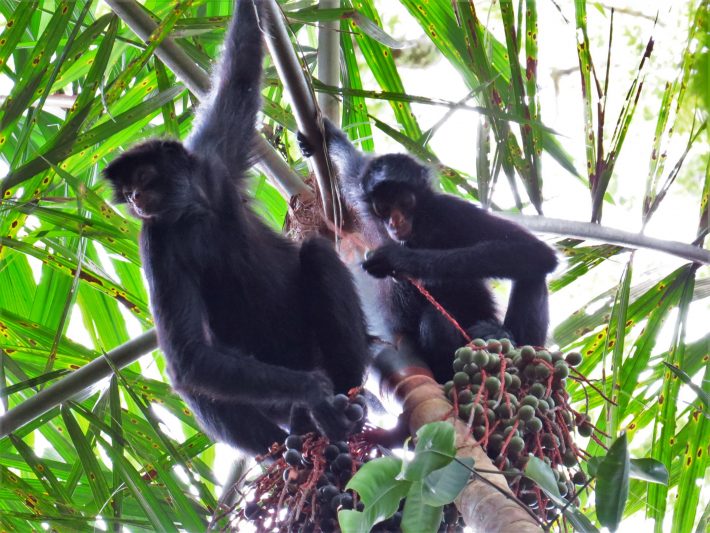Hunting is changing forests, but not in ways as previously thought
University of Connecticut press release
A new study of the Amazon rainforest by researchers at UConn and the San Diego Zoo Institute for Conservation and Research, published in the Journal of Ecology, examines what happens to plants if their seed dispersers are no longer present.

When it comes to spreading their seeds, many trees in the rainforest rely on animals, clinging to their fur or hitching a ride within their digestive tract. As the seeds are spread around, the plants’ prospects for survival and germination are increased.
But in many tropical forests, over-hunting is diminishing the populations of those animals, and, as a result, changing the make-up of the forests themselves.
A new study of the Amazon rainforest by researchers at UConn and the San Diego Zoo Institute for Conservation and Research, published in the Journal of Ecology, examines what happens to plants if their seed dispersers are no longer present.
They found that theoretical models predicting a dire impact on plant communities and huge decreases in the amount of carbon stored in tropical forests are not supported by the facts. Instead, the effects on the ecosystem are less straightforward and less immediately devastating.
“Yes, there is a negative effect, but there isn’t 100 percent mortality,” says Robert Bagchi, assistant professor of ecology and evolutionary biology at UConn. “The story is more complex and much more subtle.”
Whereas the models used in the previous studies did not use actual data on items such as mortality, survival, growth, and spatial distribution, Bagchi and his fellow researchers explored the question in greater detail, using a statistical technique they recently developed with extensive data collected on tree communities in the 80,000 km2 Madre de Dios river basin, located in the southeastern corner of Peru’s Amazon rainforest.
In Western Amazonia, as many as two-thirds of all tree species rely on native, fruit-eating mammals such as spider monkeys and tapirs, or birds like guans, trumpeters and toucans, who are able to travel fairly large distances and carry any ingested seeds far from their parent trees.
Dispersal is advantageous for seeds because spreading out will give seedlings an edge over specialized natural predators who might otherwise wipe out aggregations of undispersed plants.
“The idea is that the seeds escape,” says Bagchi.
“A lot of pathogens and insects are quite specific about which plants they will eat, and if there is no dispersal and their desired plants are densely aggregated, those plants will be clobbered.”
In addition, the tree species dispersed by these animals also store the most carbon.
Unfortunately, the large-bodied animals and birds are the favorite quarry of hunters for bush meat.
The researchers examined tree communities in the tropical rain forests of Western Amazonia, in terms of forest spatial organization and carbon storage capacity. They did find that tree communities in hunted forests appear to be undergoing a reorganization, where saplings of species that rely on large hunted animals for dispersal are now growing closer to each other and forming denser clumps in hunted forests.
But the long-term implications for biodiversity and the biomass of forests are not yet clear. And the expectation that without their dispersers, seeds of these plant species will land in the “kill zone” of insects and diseases under their parents and be replaced by other species that store less carbon, culminating in huge decreases in the amount of carbon stored in tropical forests, has not materialized.
A number of factors could be contributing to the reason that previous theories are not proving true, Bagchi says.
Smaller seed dispersers that often increase when their larger competitors are hunted out may be compensating. Additionally, the trees analyzed in the study were already at least 10-15 years old, so follow-up studies will instead focus on the early lives of these trees, starting at the germination stage.
Questions the researchers hope to pursue include, What are the survival rates of undispersed seeds in hunted forests? Is limited dispersal by smaller animals enough to ensure a seed’s survival? How do these stages fit together – does high survival at a later stage compensate for low survival of undispersed seeds?
“We can’t simplify the process to just a linear one,” says Bagchi.
“We need data following the whole process, from seed dispersal to trees growing into adults.”
Bagchi also cautions that although these findings are somewhat hopeful in light of previous modeling studies, tropical forests in South America, Asia, and Africa are becoming ever more stripped of their diversity of flora and fauna, fundamentally changing the structure of these complex systems.
This research was supported by grants from the National Geographic Society Grant Program #9487-14; the Seventh Framework Programme of the European Commission #GA-2010-267243; Directorate for Biological Sciences of the National Science Foundation #0742830.
Read the full article (freely available for a limited time):
Bagchi R, Swamy V, Latorre Farfan JP, et al. Defaunation increases the spatial clustering of lowland Western Amazonian tree communities. J Ecol 2018. DOI: 10.1111/1365-2745.12929
Media contact:
Elaina Hancock, Office of Communications, University of Connecticut. Email: elaina.hancock@uconn.edu
Like what we stand for?
Support our mission and help develop the next generation of ecologists by donating to the British Ecological Society.